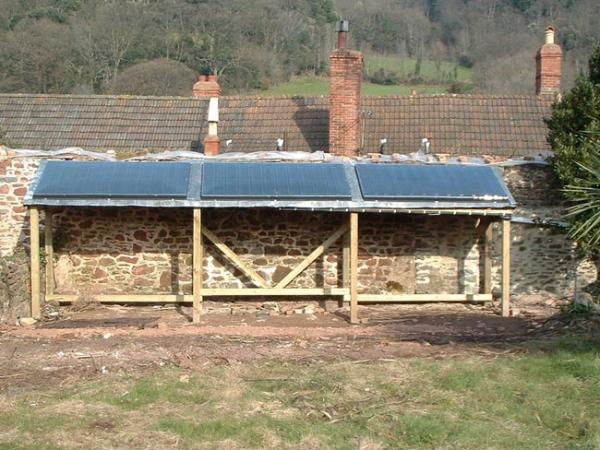Our architects who have worked tirelessly to design a modern, ecological kitchen extension to our energy-guzzling, draughty abode are, understandably keen on renewables. And so am I, providing they suit our energy and heating requirements. This post covers solar pv – the research I’ve done and the questions I’ve asked to determine whether it’s a good option for us.
Before getting into the confusing world of feed-in tariffs and depressing yourself about their 70% decrease since 2012, ask yourself two questions:
- Have you got the right location for solar pv; and
- How much electricity do you use and when.
The reason these two questions are crucial is that with the fall in feed-in tariffs, the viability of solar pv depends on maximising generation and making sure you consume as much of what you generate as possible.
In terms of location you need a south facing, unshaded area. Don’t just think in terms of your house roof. If you have a field or an under-utilised part to your garden, consider a ground mounted system. If you’re building a new shed, car port or swimming pool pagoda think about integrating solar panels into the structure. Our house is listed, so our location options are limited, but I’m working on a plan to install panels in our garden and am thinking of good ways to screen them. I’ll keep you posted on progress.


The other thing not to slip up on is summer shading. It’s very easy to plan your solar project in winter and not account for the shadow cast by a large tree in full leaf. It’s remarkable how many solar providers seem not to notice trees! South orientation is not essential and west can work but anyone who tells you north or east is fine then hastily get rid of them.
Working out how much electricity you use, and when, is important because it determines how much money you are going to make/save from your panels and therefore the number of years it’s going to take to recuperate your original investment – the payback.
Now for the confusing bit. The income from solar pv has three elements:
- The generation tariff – paid on every kwh of electricity that your panels produce.
- The export tariff – paid on 50% of what your panels produce.
- The savings you make by using your own “free” electricity rather than buying it from your electricity provider.
With recent falls in both elements of the tariff and the high price of electricity, a lucrative element of the system is the saving on using your own electricity.
The important figure is your electricity consumption in kilowatt hours (kwh) between April and October. These are the months when your panels will generate the vast majority of their electricity and if you can use as much of this on site as possible then you’ll save the most from your electricity bills and your payback period will be shortest. A 4kw solar pv system in the South of England will produce around 3,800 kwh of electricity per year but about 80% of this will be produced in the Spring/Summer months. I’m embarrassed to say that a 4kw system would cover about a third of our electricity demand (we do have an electric car but I blame it entirely on my children and their addiction to screens) but lets ignore this and base our figures on a 4kw system.
Now, maths is not my strong point but by cranking my brain into gear I can calculate the following:
- A 4kw system generates about 3800kwh of electricity a year. Assuming a generation tariff of 4.5p this earns £171 per year.
- The export tariff is paid on 50% of what’s generated (1900kwh) at a rate of 4.9p per kwh and amounts to a further £93.
- Finally, I’ve assumed that we’ll generate 80% of our electricity in the 6 sunniest months (3040 kwh) but that we’ll only ever be able to use 50% of this on site. We pay 13.97p per kwh for our electricity and so if we get 1520 kwh for “free” we will save £212 on our electricity bill.
If I add the savings/income generated then it comes to £476 per year. However, it will cost us £8000 to install a 4kw system and so with an annual income of £476 it will take over 16 years to recuperate our original investment. As you can see, this isn’t the investment opportunity of the millennium BUT if you’re serious about reducing carbon emissions; you’re able to take a long term view on staying in your house; and you install technology that means you use as much of your “free” electricity as possible then your investment will pay off – eventually!
I haven’t yet managed to persuade my unashamedly capitalist husband of the soundness of this investment opportunity but I’m working on it. The other hurdle that I have to overcome is to make sure our house achieves an energy performance rating of D because otherwise the feed-in tariffs fall to negligible levels.
My final bit of advice – be cautious about how much electricity you’ll use on site. Most of the research suggests that households use less than 50% although this is likely to change with the development of smart energy management technologies, such as Solaredge, that help you match generation with consumption.
Images above were kindly donated by R-Eco, an Oxford based Renewable Energy Co-operative.


Leave A Comment